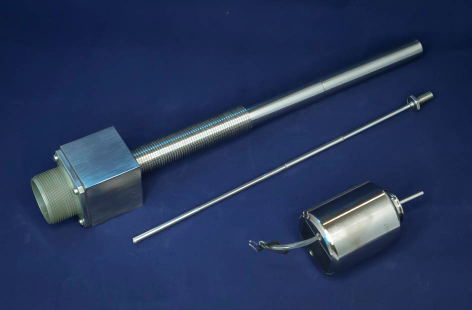The Characteristics of an LVDT
If you work in the aerospace or oil and gas industry, you need to ensure that the components you use are of high quality and reliable -- you can’t afford to experience any failures with Linear Variable Displacement Transducers (LVDTs).
An LVDT is a standard electromechanical transducer commonly used in industrial industries. They work under the principle of mutual induction and displacement by converting mechanical vibrations into a variable electrical current, voltage, and electrical signals. Let’s explore the characteristics of LVDT’s and how they work.
The Characteristics of an LVDT

The LVDT is an electromechanical instrument designed to produce an AC voltage output proportional to the transformer’s relative displacement and the ferromagnetic core. The critical LVDT sensor characteristic is their ability to perform under high vibration and shock levels when used in harsh environments.
When the magnetic core is in a central or null position, the voltage output is equal and opposite in polarity rendering the output voltage to zero. The characteristic of LVDTs makes the central or null position of them repeatable and stable. When the magnetic core is displaced from this position, coil windings will be affected by the sliding core’s proximity creating an electromagnetic imbalance. This imbalance activates a differential AC output voltage across the secondary coils, proportional to the displacement’s direction and magnitude in a linear path.
Although an LVDT is an electrical transformer, LVDT output characteristics require AC power of amplitude and frequency, utterly different from standard power lines, to operate correctly. LVDT’s have an infinite lifecycle when used because they are virtually frictionless. They don’t contain any electronics and are designed to operate at cryogenic temperatures of up to 1200 °F (650 °C).
LVDT Sensor
LVDT’s are a passive type of sensor and commonly used in commercial, industrial, and aerospace industries.
The standard parameters required in aerospace, military, robotics, control applications, and scientific measurement are sensing physical position. Analog circuitry or digital calculation will determine velocity and acceleration by differentiating the position data concerning time. Selecting a suitable position-sensing transducer delivers distance, ruggedness, price, accuracy, physical access, placement, non-contact, contact, and many other factors.
Sentech’s multi-channel LVDT’s (Linear Variable Position Transformer) offer redundancy in case of a sensor break or failure.
LVDT Advantages
The key advantage of an LVDT is that no parts can rub together or wear out because there’s usually no contact between the LVDT's core and coil structure, giving it an unlimited mechanical life. This factor is significant in high-reliability LVDT applications such as aircraft, satellites, space vehicles, and nuclear installations. It is also highly desirable in many industrial process control and factory automation systems.
LVDT Construction

A typical LVDT consists of a movable core of magnetic material using a three coil system. The center coil is the primary coil supported by two secondary coils or pick-up coils. Typically a 1 to 10 kHz AC excitation is passed through the primary coil enabling AC voltage to be generated in the secondary coils. The magnetic core inside the coil winding assembly furnishes the magnetic flux path, which links the primary and secondary coils.
The LVDT consists of three solenoidal coils. The primary coil is wound on the tube then two secondary coils are layer wound on top of the primary on the tube. As the core moves, it links to two secondary coils causing the induced voltages to change. These coils are connected so that the output voltage is the differential between the top secondary voltage and the bottom secondary voltage.
It moves without friction because the sliding core doesn’t touch the inside of the tube, making the LVDT a highly reliable device. The absence of sliding or rotating contacts allows it to be completely sealed against the environment.
In the world of sensing solutions for a range of applications, the manufacturer must offer reliability, performance, a long life, and service excellence. When it comes to custom electromechanical sensing and actuation for the industrial and aerospace market, you want assurance you receive a quality product. Designing for mission-critical and demanding applications, Sentech has proven to be the right source for many loyal customers.
Sentech is a global leader in designing and manufacturing position sensors, including LVDTs, RVDT’s, FASTAR sensors, HYDRASTAR sensors, signal conditioners, and solenoids. Working with us will give you peace of mind as all our products are manufactured according to ISO 9001:2015, AS9100 Rev D certified processes, and ANAB accreditations.
Key Takeaways:
- LVDTs are exceptional for areas where there will be friction and moving parts
- Uses of LVDTs include high-reliability applications such as aircraft, satellites, space vehicles, and nuclear installations
- Multi-channel LVDTs help provide a level of redundancy in case of an outage or break
If you are looking for custom, tailored solutions for mission-critical applications such as power generation, industrial, and aerospace environments, contact us today for a free consultation. With over 30 years of experience in the industry, you can be confident in our products’ quality, outstanding service, and guarantees.


